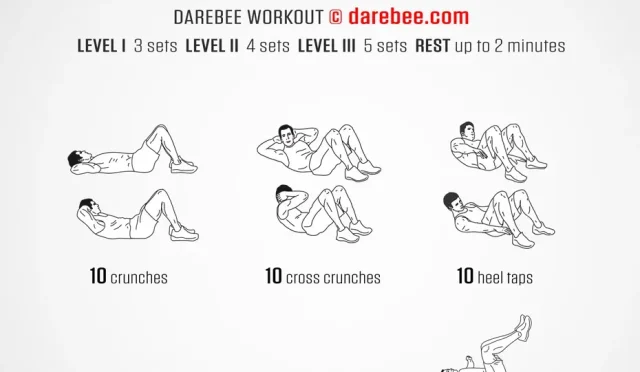Cardiorespiratory Fitness: Boost Health with Structured Training
Cardiorespiratory fitness (CRF) is an essential marker of overall health, reflecting the efficiency with which the heart, lungs, and muscles work together during physical activity. As highlighted in recent studies, improving cardiorespiratory fitness is not only beneficial for boosting athletic performance but profoundly impacts health outcomes, reducing morbidity and mortality rates. Engaging in aerobic exercise significantly contributes to cardiovascular health, promoting enhanced stamina and endurance while decreasing the risk of chronic conditions. By incorporating CRF assessments into fitness training programs, clients can set realistic goals rooted in health benefits, aligning their motivation with tangible improvements in well-being. Ultimately, the transformative nature of cardiorespiratory fitness underscores its importance as a cornerstone of a successful fitness journey, facilitating a path towards a healthier life.
Cardiorespiratory health, often referred to through terms such as aerobic capacity or cardiovascular endurance, plays a pivotal role in ensuring optimal health. This vital component of an individual’s fitness profile is critical for enhancing various aspects of well-being, from improved energy levels to reduced risks of severe health issues. Engaging in sustained aerobic activities not only builds stamina but also improves the efficiency of the heart and lungs, leading to longer life expectancy. Emphasizing the importance of maintaining a strong aerobic base, fitness professionals can craft targeted training regimens that resonate with clients’ personal goals and lifestyles. Ultimately, prioritizing cardiorespiratory health is essential for fostering a thriving, active life.
The Benefits of Cardiorespiratory Fitness for Health Outcomes
Cardiorespiratory fitness (CRF) is pivotal in determining the overall health of an individual. Numerous studies, including the comprehensive analysis by Lang et al. (2024), demonstrate that increased CRF is associated with significant decreases in morbidity and mortality rates. The study suggests that even modest improvements in CRF can lead to remarkable health benefits, such as lowered risks for cardiovascular diseases and extended longevity. Consequently, fostering CRF should be a primary goal in fitness training programs, as it not only enhances physical capabilities but also contributes positively to long-term health outcomes.
Moreover, improving CRF encourages a proactive approach toward fitness and wellness. Individuals who engage in regular aerobic activities, such as running, cycling, or swimming, see substantial improvements in their cardiovascular health, leading to better endurance and energy levels in everyday life. By incorporating CRF assessments into personal training regimens, fitness professionals can set measurable goals for their clients, reminding them that their fitness journey positively impacts their overall health, rather than merely focusing on aesthetic gains.
Implementing Effective CRF Assessments and Monitoring
To maximize the benefits of cardiorespiratory fitness, incorporating regular assessments is essential in any fitness training program. Fitness professionals should begin with baseline evaluations using submaximal tests, like the 6-minute walk test or various step tests, which can help in gauging current CRF levels. Following this, periodic reassessments can chart progression, allowing trainers to provide tailored feedback and adjust workout intensities accordingly. This systematic approach ensures that clients remain engaged and motivated as they work towards improving their cardiorespiratory fitness.
In addition to monitoring physical improvements, client education plays a critical role in enhancing compliance and understanding of the training process. By discussing the relationship between CRF and health outcomes, trainers can more effectively communicate the significance of regular aerobic exercise. Clients who are educated about how improved CRF can lead to reduced health risks tend to adhere better to their exercise programs. Integrating data from relevant studies, such as Lang et al., can help in illustrating these points and fostering a comprehensive understanding of the role CRF plays in enhancing quality of life.
Designing Inclusive Fitness Programs for CRF Improvement
Creating inclusive fitness programming is crucial for engaging clients of varying fitness levels to improve their cardiorespiratory fitness effectively. A well-structured program should offer modifications and progressions that respect the individual capabilities and preferences of clients. Introduction of diverse aerobic exercises, such as group cycling, swimming, or moderate running, can keep the training exciting and adaptable. Tailoring these activities to align with individual preferences can significantly increase client adherence and enjoyment, which are essential factors for long-term commitment to fitness.
Furthermore, integrating a variety of intensity levels within workouts can help in catering to different clients’ needs. By employing techniques like interval training and mixing lower-intensity efforts with short bursts of higher intensity, trainers can strategically improve their clients’ CRF while minimizing the risk of burnout. Offering flexibility in session formats—whether it’s through home workouts, gym sessions, or outdoor group classes—ensures that all clients feel comfortable and motivated to participate in their fitness programs.
Maximizing Aerobic Exercise Benefits for CRF
Aerobic exercise serves as a cornerstone in the development of cardiorespiratory fitness, offering numerous benefits that extend beyond mere physical capabilities. Engaging in regular aerobic activities can enhance lung capacity, improve circulation, and strengthen the heart muscle—key factors that contribute to overall improved health outcomes. Incorporating a variety of aerobic exercises into fitness regimens not only accelerates progress in CRF but also encourages clients to discover enjoyable activities that resonate with their fitness lifestyles.
Additionally, the benefits of aerobic exercise are cumulative; over time, consistent participation can lead to significant results. The emphasis on long-term commitment in fitness programs ensures that clients are more likely to experience enhanced cardiovascular health and reduced risks associated with chronic diseases. Consequently, fitness professionals should prioritize developing cycling programs, swimming routines, and other aerobic sessions that are designed to educate clients on the transformative advantages of improved CRF, providing them with motivation and knowledge to sustain their fitness journeys.
This Evidence-Based Approach to Training Client Health
Incorporating evidence-based practices into personal training not only empowers fitness professionals but also supports clients’ overall health for better life quality. The findings from Lang et al. highlight that prioritizing cardiorespiratory fitness as a key aspect of any fitness training program can drastically reduce health risks associated with sedentary lifestyles. By leveraging scientific evidence to inform their training methods, personal trainers can cultivate more effective routines that resonate with clients’ health objectives while simultaneously addressing their fitness goals.
Implementing these strategies cultivates an environment of trust and accountability, as clients witness tangible changes in their health metrics linked to improved cardiorespiratory fitness. Repeatedly revisiting the importance of CRF within training discussions and program designs will also ensure ongoing motivation and commitment from clients. Moreover, fitness professionals who effectively communicate the role of CRF will have more success in helping clients appreciate their fitness journeys, leading to healthier lifestyle choices well beyond the gym.
The Role of Lifestyle Changes in Enhancing CRF
Lifestyle changes play a vital role in improving cardiorespiratory fitness and overall health outcomes. By focusing on aspects such as nutrition, sleep, and stress management, clients can significantly enhance their fitness results. Personal trainers who educate clients on these lifestyle elements empower them to make informed decisions that complement their training efforts, leading to a holistic approach to health.
Additionally, integrating motivational strategies that encourage clients to adopt healthier lifestyle choices can further enhance their CRF. By setting achievable goals and celebrating small successes along the way, trainers can cultivate a supportive environment that nurtures progressive health habits. Encouraging clients to share their experiences and challenges fosters community and support, which is essential for sustaining long-term lifestyle changes that positively impact cardiorespiratory fitness.
Periodization: A Key Element in CRF Programming
Implementing periodization in training programs is crucial for maximizing improvements in cardiorespiratory fitness. This approach involves systematically varying training intensity, volume, and frequency over a defined period. By incorporating distinct phases, fitness trainers can effectively challenge clients, facilitating ongoing fitness adaptations. The structured progression allows individuals to build a solid aerobic base before advancing to more complex and intense workouts that align with their evolving fitness levels.
Furthermore, periodization fosters an environment where clients can achieve continual growth without falling into the rut of monotony. By introducing new exercises, intensity levels, and durations, trainers can maintain client engagement and minimize the risk of overuse injuries. This strategic planning not only promotes improvements in CRF but also contributes to enhancing clients’ enjoyment of their fitness experience, motivating them to stay committed in the long term and improve overall health outcomes.
Optimizing Fitness Training for Cardiovascular Health
The intersection of cardiorespiratory fitness and cardiovascular health is a vibrant area of interest for fitness professionals and clients alike. It’s crucial to adopt fitness training programs that emphasize not only the improvement of CRF but also the substantial implications these improvements have on heart health. The evidence suggests that investing in cardiovascular fitness through regular aerobic exercise can lead to significant decreases in heart disease risk, making it a paramount focus in personal training.
Consequently, trainers should craft programs that prioritize cardiovascular conditioning, integrating a diverse range of exercises that stimulate heart health effectively. Activities like running, cycling, and brisk walking have shown to elicit substantial benefits, improving clients’ heart function, blood circulation, and overall performance in their daily lives. By consistently reinforcing the connection between fitness training, CRF, and cardiovascular health, trainers can motivate their clients to embrace their journeys toward better health with enthusiasm and purpose.
Conclusion: The Path to Enhanced Client Health through CRF
The growing body of evidence surrounding the importance of cardiorespiratory fitness underlines its pivotal role in the health and wellness of individuals. By integrating CRF-focused training approaches into fitness programs, trainers can create profound impacts on their clients’ health outcomes. As demonstrated by the findings of Lang et al. (2024), improving CRF is linked to lower mortality and morbidity risks, making it a crucial aspect of any comprehensive fitness strategy.
As fitness professionals continue to evolve their understanding of CRF and its implications for overall health, they can foster a client-centric approach that prioritizes fitness for long-term wellness. This not only encompasses structured training regimens but also integrates education on holistic health practices. Ultimately, the commitment to enhancing cardiorespiratory fitness will serve as a catalyst for life-changing health improvements, equipping clients to lead healthier, more fulfilling lives.
Frequently Asked Questions
What are the benefits of improving cardiorespiratory fitness (CRF)?
Improving cardiorespiratory fitness (CRF) offers numerous benefits, including reduced risks of morbidity and mortality. High levels of CRF are associated with a significant decrease in the risks of all-cause mortality, heart failure, and cardiovascular diseases. Enhanced CRF also contributes to overall better health outcomes, improved aerobic capacity, and greater longevity.
How can a fitness training program improve cardiovascular health through cardiorespiratory fitness?
A structured fitness training program focusing on cardiorespiratory fitness can dramatically enhance cardiovascular health. By incorporating aerobic exercises such as running, cycling, or swimming, individuals can effectively increase their heart and lung efficiency, promoting better blood circulation and oxygen use, which are critical for maintaining cardiovascular health.
What role does aerobic exercise play in enhancing cardiorespiratory fitness?
Aerobic exercise plays a vital role in enhancing cardiorespiratory fitness (CRF) by increasing the heart rate and promoting better oxygen utilization throughout the body. Regular aerobic activities like jogging, swimming, or cycling contribute to improved endurance, increased metabolic rates, and overall enhanced health outcomes.
Why is it essential to include cardiorespiratory fitness in a client’s fitness training program?
Including cardiorespiratory fitness in a client’s training program is crucial as it serves as a predictor of overall health and longevity. Improvements in CRF are linked to reduced risk of chronic diseases, enhanced quality of life, and increased exercise capacity, making it an essential component for effective fitness coaching.
How does incorporating CRF assessments improve fitness training programs?
Incorporating cardiorespiratory fitness assessments into fitness training programs allows trainers to set personalized goals, monitor progress, and adjust training intensity effectively. These assessments help clients understand the relationship between their CRF improvements and overall health outcomes, motivating them to adhere to their fitness goals.
What types of aerobic exercises are recommended for improving cardiorespiratory fitness?
To improve cardiorespiratory fitness, a variety of aerobic exercises are recommended, including brisk walking, jogging, cycling, swimming, and group fitness classes. These activities, when performed regularly, can significantly enhance cardiovascular health and aerobic capacity.
Can beginners successfully improve their cardiorespiratory fitness?
Yes, beginners can successfully improve their cardiorespiratory fitness through a well-structured training program tailored to their initial fitness levels. Starting with moderate-intensity aerobic activities and gradually increasing the duration and frequency will help them build a solid aerobic base, leading to significant CRF improvements.
What is the relationship between cardiorespiratory fitness and mortality rates?
Research has shown a strong relationship between cardiorespiratory fitness (CRF) and mortality rates. Each unit increase in CRF is associated with an 11%-18% decrease in all-cause mortality risk, highlighting the importance of focusing on CRF as a critical determinant of long-term health and longevity.
| Key Findings | Practical Applications | Periodized CRF Improvement Program |
|---|---|---|
| – High levels of CRF reduce morbidity and mortality risks. – Each 1-unit increase in METs decreases all-cause mortality risk by 11%-18%. – Integrating CRF assessments can motivate clients towards health goals. | – Regular CRF assessments using tests like the 6-minute walk test. – Educate clients on CRF and its long-term health benefits. – Develop inclusive fitness programs tailored to varying fitness levels. | **Phase 1**: Foundation (Weeks 1-4) – Frequency: 3 days/week – Intensity: 55-65% HRmax – Duration: 20-30 mins**Phase 2**: Improvement (Weeks 5-8) – Frequency: 4 days/week – Intensity: 65-75% HRmax – Duration: 30-40 mins **Phase 3**: Maintenance and Peak (Weeks 9-12) |
| The comprehensive review emphasizes the importance of cardiorespiratory fitness (CRF) in enhancing overall health, significantly lowering the risk of chronic diseases and mortality. As evidenced by substantial research, improving CRF should be a primary focus for fitness professionals and clients alike. | ||
Summary
Cardiorespiratory fitness (CRF) is fundamental to health, as research by Lang et al. (2024) illustrates its significant impact on morbidity and mortality rates. Fitness professionals should prioritize CRF improvement in their training programs to help clients achieve healthier lives and reduce chronic disease risks. By employing structured CRF assessments and modern, inclusive workout regimens, we can motivate clients towards long-lasting health benefits.
#CardiorespiratoryFitness #StructuredTraining #HealthOptimization #FitnessGoals #ExerciseScience








